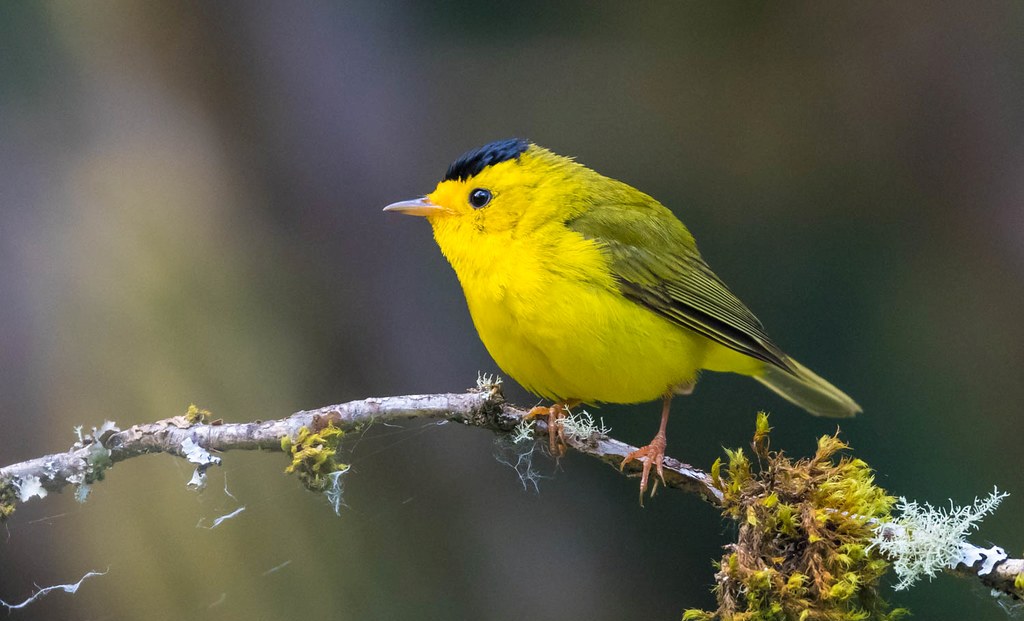Wilson’s warbler Songs
Wilson’s warbler songs are made up of multiple loud descending notes that chatter together. Wilson’s Warblers’ songs consist of simple, sweet, and melodious tunes. Wilson’s warbler Songs are fast and slightly accelerating, ringing loud and clear even next to noisy streams as they drop in pitch toward the end. A flat “chuff” is Wilson’s warbler’s call.

Wilson’s Warbler: Cool Facts
- It is one of the smaller members of the New World warbler family (Cardellina pusilla).
- A long, slim tail and rounded wings distinguish this species from others. It is a greenish bird above and yellowish below. Males have a black crown patch; females have a reduced or absent mark, depending on the subspecies. The underpart is yellow and green-brown is the only distinguishing characteristic of this bird.
- This warbler breeds in northern Canada and the western United States; it winters near deforested edges, deciduous forests, tropical evergreen forests, pine-oak forests, mangrove swamps, thorny shrubs, riparian gallery forests, brushy fields, and mixed forests. Secondary growth, riparian habitats, and lakes, as well as mountain and boreal forests with clear-cuts overgrown, are its preferred habitats at all times.
- The nest building is performed by the female. Typically, cup nests are made out of vegetation and lined with grasses and hair. It is usually buried in moss or sedges at the base of shrubs. Except in coastal California and Oregon, Wilson’s Warblers nest on the ground most of the time, with a few nesting up to 5 feet off the ground. Wilson’s warbler fledglings may spend a night or two in the nest after fleeing after leaving the nest, although most songbird nestlings leave the nest immediately after hatching. In the west coast population, nesting begins in early March, while in the northern range, it extends into August.
- The warbler spends winters in much of Central America, from Mexico southward. It breeds across Canada and the southwestern United States. It is one of the rarest vagrants in Western Europe.
- Wilson’s warblers are small passerines that measure about 11 to 12 centimeters long, have wingspans of 15 to 17 centimeters, and weigh between 6 and 10 grams.
- Compared to males of the eastern, nominate race, western C. p. chryseola are greener and brighter than males of the eastern, nominate race.
- A slight difference exists in average size between Alaskans and those living along the west-central coast and the eastern and Pacific coasts of the species’ range.
- Wilson’s warblers are similar to yellow warblers, but the latter is readily distinguished by the yellow colors on its wings and tail.
- Streams, ponds, bogs, and wet clearings provide moist breeding habitats in relatively open woodland with shrubs and thickets.
- Two to seven creamy or off-white eggs with fine reddish spots are laid in each clutch. There is an altruistic nature to the young. Nest success rates and clutch sizes are generally higher among montane populations than coastal populations.
- At about 12–15 days after hatching, the young hatch out and begin living on their own; adults care for them for a period of several weeks afterward.
- It is not uncommon for mountain populations to have polygamous males (one male can breed with multiple females). The brown-headed cowbird frequently feeds on Wilson’s warbler.
- Insects are the main food source for Wilson’s warblers, which feed primarily on insects gleaned from leaves and twigs or caught by fly-catching. Caterpillars, and beetles, are among the insects that this warbler lives on. Occasionally, it consumes berries as well.
- When the birds are foraging in the winter, Wilson’s warblers move quickly through shrubs, along the ground, and sometimes between trees.
- The twitching of their tails and fluttering of their wings are commonly observed in feeding birds. In both males with and without mates, the observed feeding rate of Wilson’s warblers did not differ significantly.
- Wilson’s warbler is commonly known as the “green black-cap flycatcher,” which was described in 1811 by Naturalist Alexander Wilson, the year he called it the “father of American ornithology.”
- During banding operations in California in 2008, a male Wilson’s warbler was recaptured and rereleased at least 8 years and 11 months old. His original banding took place in 2000 in the same state.
Read More: Prothonotary Warbler: The Most Striking Warbler of North America

Wilson’s warbler songs are made up of multiple loud descending notes that chatter together. Photo Credit – Andrew Reding






